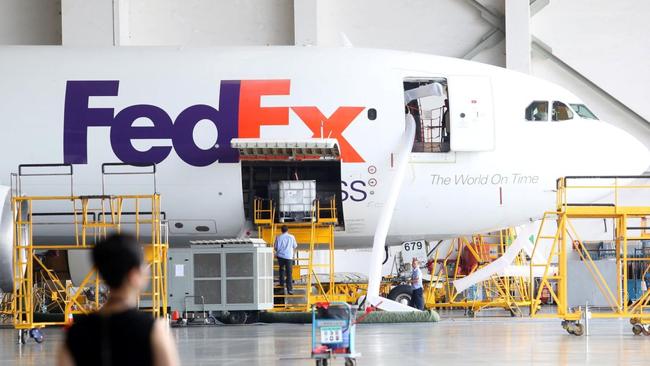End of free shipping era? FedEx sees change in mindset over cost
FedEx’s Australian boss Peter Langley says more people are now willing to pay extra for shipping to get their parcels on time.

Inbound international parcel volumes have more than doubled during COVID-19, with global logistics giant FedEx tapping into its network of 670 air-freighters to minimise delays that have plagued other delivery services throughout the pandemic.
But swift delivery comes at a cost, which has long been a friction point in e-commerce — with online giant Amazon spending billions each year on free shipping to keep shoppers sticky.
As the pandemic fuels lengthy delays — not just for parcels sent from overseas but even items sent between Australian cities and regions — Peter Langley, vice-president for FedEx Express Australasia, says the mindset among customers is shifting.
“People are getting used to paying for (express shipping) because the issue is if we can’t bring it in, you are looking at two to four months on the sea to get it here,” he said.
“That’s the choice people have to make — do you want the product, and therefore do you want to pay for it?
“I like to use the analogy of the newspaper industry, which went from hard copy to digital and then the fact they gave away the digital for free.
“Now people are starting to push back — every time you get an article off one of the feeds, the first message that comes up is ‘would you like a monthly subscription and it’ll be $6 for the first few months’.
“The same thing is happening in the transport industry and in B2C (business-to-consumer deliveries). People understand that there is a higher cost and if they really want the product, they will pay for it.”
Australia Post, which dominates the domestic B2C market with more than 80 per cent market share, has warned for months of delays across its standard and express services as its network has been overwhelmed, delivering 300 million parcels since the start of the pandemic.
At the same time, passenger aircraft flights — which couriers rely on to send parcels across the country and overseas — have slumped 73 per cent on a year-on-year basis.
But Mr Langley said FedEx had largely been able to avoid those delays, combining its domestic network — which it acquired when it purchased Dutch logistics company TNT for $US4.8bn ($6.8bn) in 2016 — with its global operations.
“We have not seen the same delays. We have now got a very good network and that network for FedEx includes 670 aircraft — the biggest air-freighter network in the world.
“So we are in the fortunate position that we have got the aircraft. Our only challenge was trying to get them down to Australia often enough, which we were able to do.”
Tapping into the world’s biggest air-freighter network led to FedEx doubling its international inbound parcel volumes.
“Last year, we were a bit short of 5 per cent of volume inbound in airfreight, and this year we are a bit over 12. So we were the biggest operator of freight in and out of Australia.
“And that freight is not just general airfreight — in terms of people having to move mining machinery or things like that — that’s people paying express rates to bring product in.
“For e-commerce, with the doubling in the volume, we have been able to bring that in with the aircraft and inject that into what was just the domestic TNT system and get those deliveries done.”
To keep a lid on costs and avoid missed deliveries, FedEx is giving customers the option of taking delivery of their parcels at one of 1400 BP stations or newsagents, minimising the number of delivery points for drivers.
“We have a lot of customers where the traffic mix that was going into the bricks and mortar has come down and we are doing more consumer deliveries for them,” Mr Langley said.
“We take a delivery of let’s say two cartons with 100 shirts and take that down to Chadstone or Bondi Junction or somewhere and we drop it off at a retailer — that’s one delivery for 100 shirts.
“Now what is happening is a much larger proportion of those 100 shirts are getting delivered to homes one or two shirts at a time, so the costs are higher for consumer delivery for sure. It’s how you make that all work.”





To join the conversation, please log in. Don't have an account? Register
Join the conversation, you are commenting as Logout